In a bid to conquer the middleweight sportsbike sector, Ducati’s rewritten the rule book on its Panigale V2, starting afresh with a lither, smarter and more focused protagonist. Bruce Wilson took it for a pootle…
While some people might question how less can be more, it’s an ethos that Ducati’s played out wholesale with the brand’s new Panigale V2. The headline-grabbing news with the model is the drop in performance, not a mere one or two ponies, but a whopping 30-plus-bhp. Could less really be more? Well, that question buzzed around my head relentlessly ahead of the launch of the new 890cc v-twin-powered protagonist at the recently opened Sevilla race track in the south of Spain.
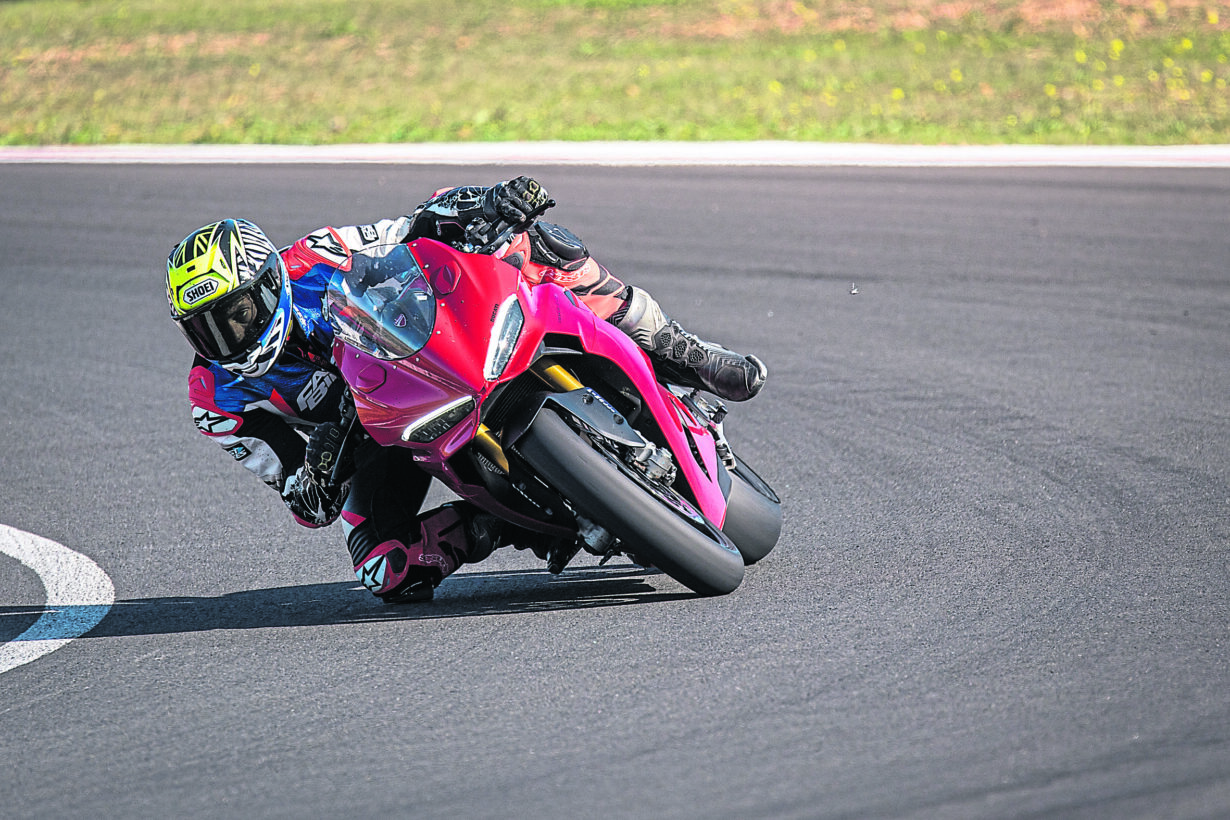
To cut to it, power is everything, right? There’s no denying it, but if I knew little else about Ducati than its uncompromising passion for performance first and everything else second, I was obliged to have faith in its new direction and the entirety of the package, which not only saw the introduction of the aforementioned, wholly new – desmodromic deprived – motor, but also a new monocoque frame, double-sided swingarm, a raft of new tech – including a next gen 5” TFT dash – and, perhaps most significant of all, a weight drop of 17 kilos.
Enjoy everything More Bikes by reading the MoreBikes monthly newspaper. Click here to subscribe, or Read FREE Online.
Yep, you read that right. Imagine how much faster, lighter and fitter you’d feel having pied off that much mass. Or in motorcycle parlance, how much quicker you’d accelerate; how much easier you’d corner; how much sharper you’d stop.
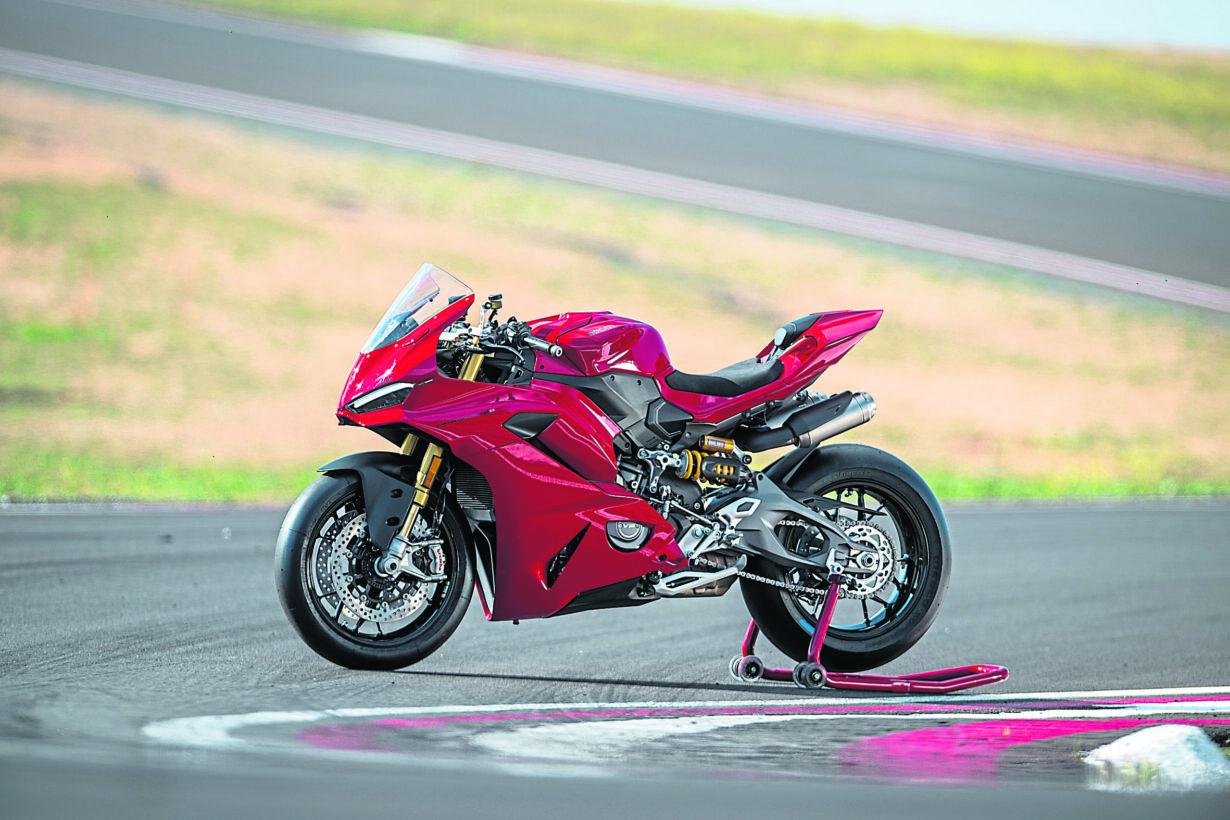
I’ll admit, as excited as I was about the V2’s new look, which follows suit of the V4 Panigale’s sleeker and slipperier stance, or the introduction of new Y-spoke wheels, or the fancy Ohlins suspension that adorned the V2S spec machines we were to ride – it would have meant little from a pure performance point of view without that hefty weight loss. Power-to-weight is everything and while the slimming world approach hasn’t quite rendered the drop in output equal, it has meant that the old bike and the new bike are much closer when the pin is pulled than you might think.
That was a point that got properly hammered into us ahead of this launch, with Ducati claiming that in testing, the new, lesser-powered V2 nearly matched its predecessor’s lap time at Vallelunga race track, near Rome, being just 0.2 seconds a lap steadier. How so? Well, in Ducati’s opinion, the added virtues of better tech, improved handling and far less weight outweighed the power that’d gone walkies.
Turning up at a tropical (18˚C), shiny and new Sevilla race track, the excitement to get stuck in and kick off the first of six 15-minute stints felt palpable. But before such antics could get underway, we were first given a chance to see the V2 unclothed and stripped down, highlighting the bits of the build that you wouldn’t typically see, such as the minuscule monocoque chassis, that looked about as wide as a shoe box and probably weighed the same, too. Okay, that last figure might be a bit of an exaggeration, but hitting the scales at just four kilos, it also brought about a refined level of flex to the V2 name… and doubled up as the bike’s airbox while it was at it – talk about getting your money’s worth.
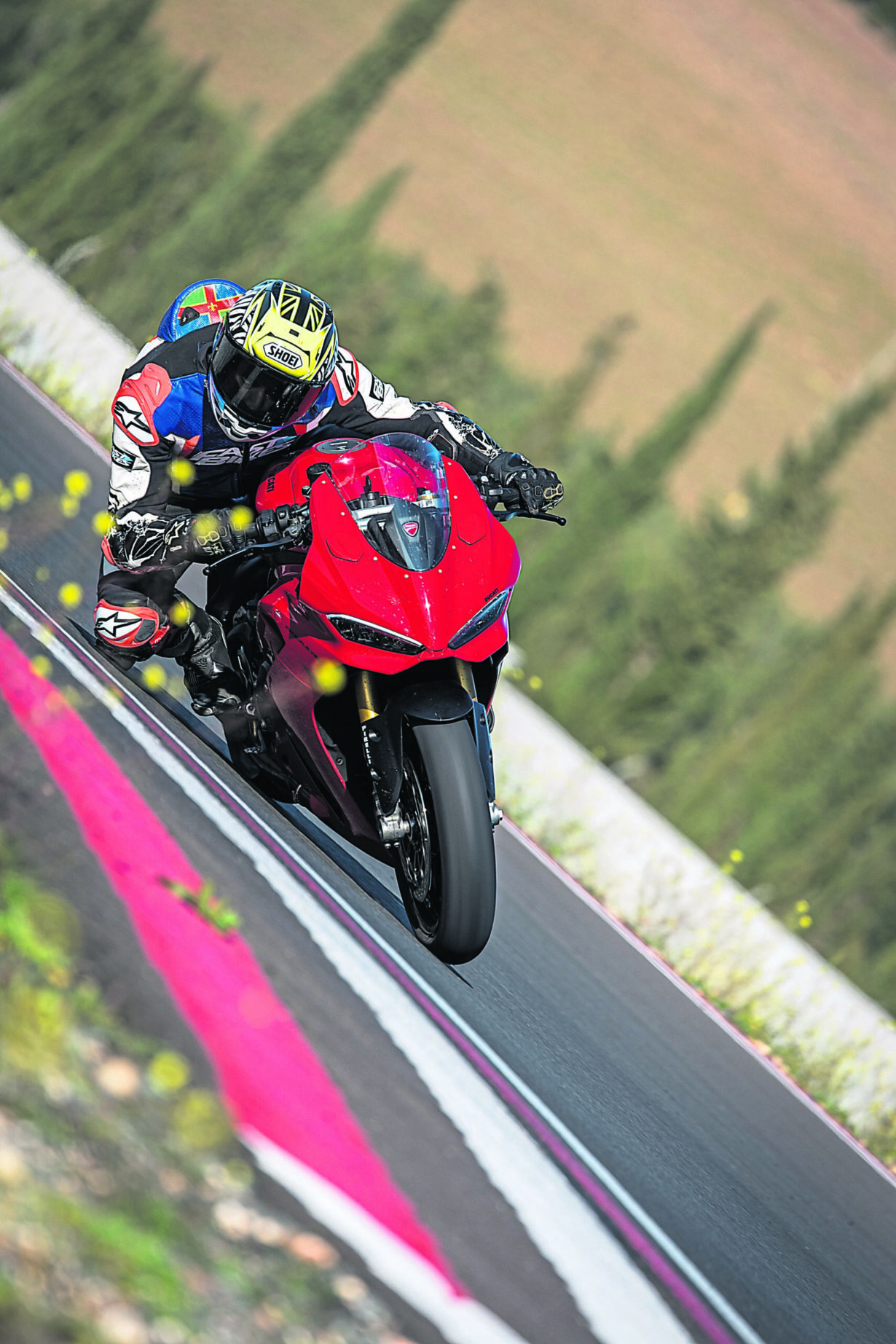
Below it slotted the feature piece v-twin which was said to have been built from a blank piece of paper with two clear goals: to achieve a 120hp output and lose a shed load of weight. To be more precise, nine kilos was the target figure over the previous version’s motor, and 9.4kg was the final result. You might be wondering whether they’d forgotten to put pistons in it or something, considering such a substantial drop in mass, but the engineer behind the motor mentioned that most of the weight came from the use of thinner metals and the dropping of the Desmodromic valvetrain system. To hardcore Ducatista out there, the loss of the Desmo tech might be considered sacrilege, but the reasons for doing so are quite simple: it wasn’t needed, it saved weight, and it saved cost.
What became very clear, very quickly, was that Ducati hadn’t gone about trying to build an improved version of what’d come before, but something entirely different, more purposeful and more relevant to what the market actually wants right now, as opposed to the continuation of a model that was neither a litre bike or a middleweight – and for that reason, didn’t really fit in anywhere. In other words, the message became clear that despite the obvious comparisons, the only thing the new V2 had in common with its predecessor was its name… and even that’s probably in a slightly different font.
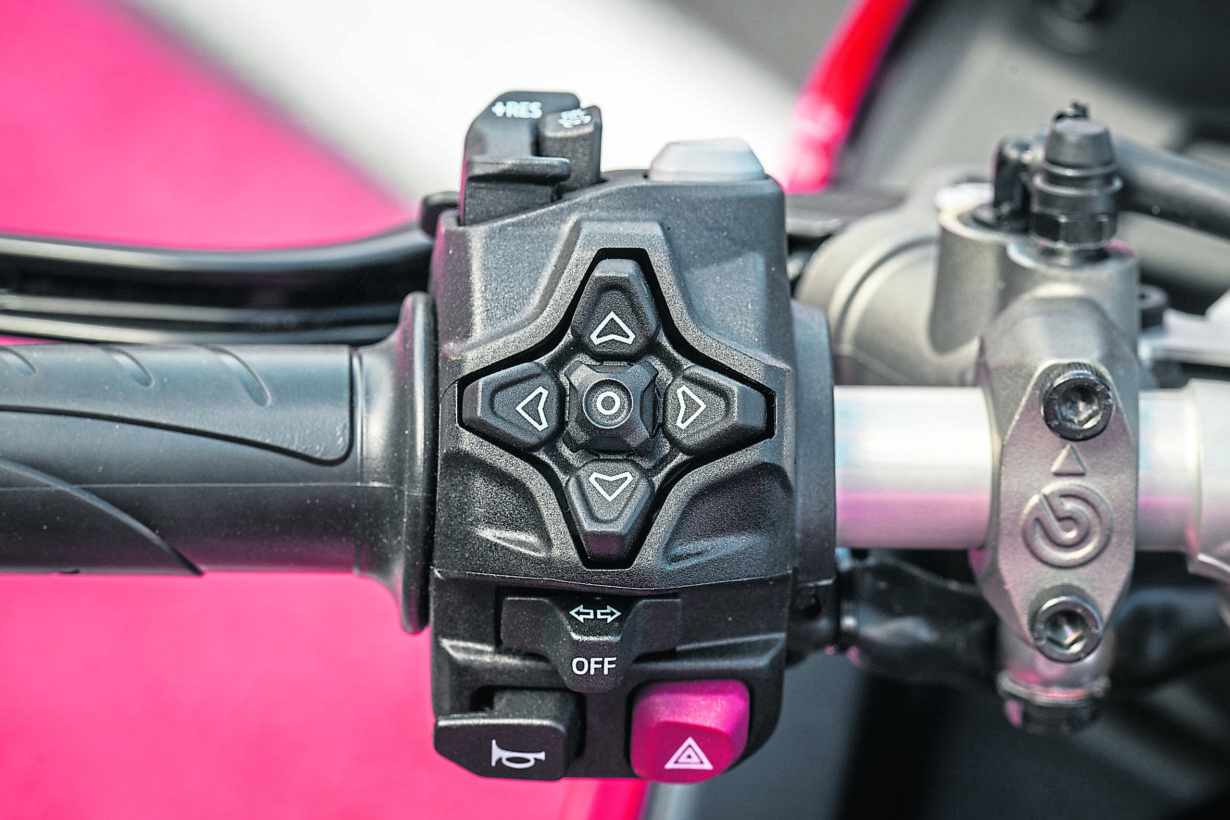
Armed with more facts than my tiny brain could hold, our track debut eventually commenced… and so did the surprises. Chief of all was the sensation of acceleration this thing offered. Heading out of pitlane, with no idea which way the track went, I couldn’t resist a handful of throttle, to which the Pani obligingly romped forwards at a truthfully unexpected rate. From that moment on, the engine didn’t stop impressing me.
I’ll spare you the melodrama of getting my head around the circuit and fast-forward to a few sessions in when I was setting a decent pace, having gained a good grasp of what the v-twin had to offer. Top amongst all its good traits was a very linear dose of oomph, made so consistent owing to the new engine’s use of variable valve timing on the inlet cam. From just 4000rpm, 80 per cent of the Ducati’s torque was on tap and that figure stayed consistent up to 11,000rpm. On paper, that sounds impressive, and on a dyno map, that kind of plot is the stuff of dreams, but from a pure riding experience, what it meant was the V2 never felt lacking, regardless of gear choice or engine speed.
I soon learned that even if I’d messed up, the v-twin could quickly and easily pull me out of a pickle with an unintimidating supply of drive, that seemed to rise through the revs at a fair rate of knots, before petering off around 10,000rpm. At that point, I’d snick another gear, using Ducati’s second-generation shifter system, and plough on merrily into the distance… until it was time for some more panicked braking. Honestly, the motor not only felt exhilarating, but also it made me feel like I was the boss of it, because despite the bark from the stylish-looking twin silencers, the engine was so pliable and user-friendly. There were no peaks or troughs, no sign of a harsh pickup, and even the back-torque on offer failed to cause too much drama when banging down several gears in quick succession.
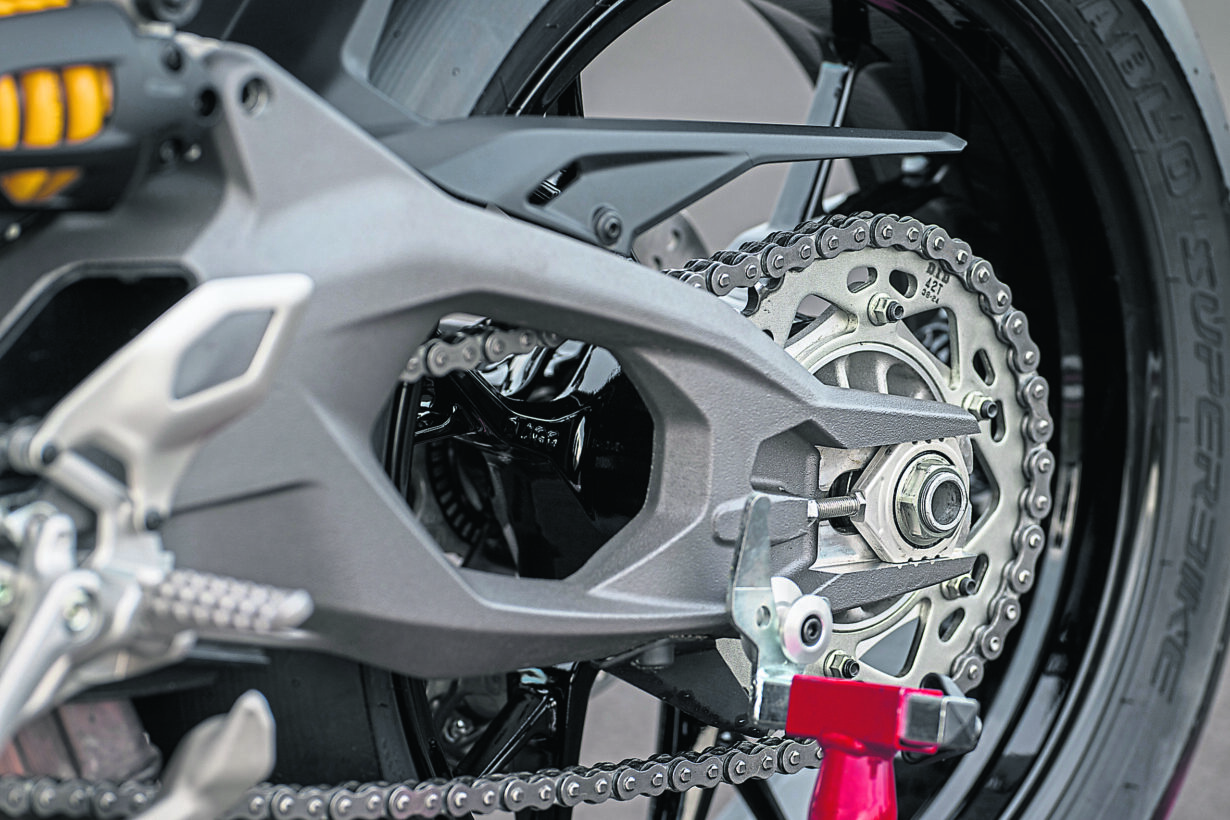
However, that kind of abuse did cause the motor to throw a few red warning lights my way, lighting up the dash in a show of frustration, asking me to stop taking the mick and calm things down before valve-met-piston. The more methodical I was with the engine, the more giving it proved, which is quite typical of most v-twins, in my experience. They need to be ridden differently, leaning less on higher revs and more on the bountiful amounts of torque on offer. To that extent, I learned to almost always hook a gear higher when tackling some of the faster, flowing sections, not only to smooth the gig out, but also to avoid running out of revs. As great as the limiter sounded, hitting it definitely hurt my lap time.
Another thing that’d hurt my lap time was missing apexes, which was easier said than done on the relentless blind and twisting circuit. It really did take a bit of getting used to, but by early afternoon I was on a solid pace and leaning heavily on the attributes of the V2’s handling prowess. This is one of those times that I have to rein myself back from getting all giddy and claiming this to be the best handling bike ever, because it’s not, but what it is, is surprisingly agile, super-easy to hold a line on and impressively stable under hard acceleration or when braking all-out into one of the track’s many hairpins.
The Ohlins on our machines had been given a solid base set up, with my only issue being a slight lack of support at the rear – prompting 2mm of preload being added. Doing this not only minimised the sensation that the rear shock was pumping, but also it made the Pani even sharper handling… to the extent that on a few occasions I had to pick the bike up for fear of cutting the grass on the inside of an apex. Honestly, the way this thing handles is a treat and as hung up as I am about the engine, I’d actually say that the way the Ducati corners is equally – if not more – impressive.
For me, the very best thing about it is the front-end feel, which gave me the confidence to dick around and scratch an elbow at will. Not once did I feel the Pirelli slicks beneath complain, or the support from the Ohlins begin to lack. How much of this sensation can be attributed to the new frame and swingarm is anyone’s guess, but what I will say is that as a package, it all works so well, and felt great regardless of whether I was tackling a second gear corner, or when pinned over a blind cresting bend in fifth.
Can I say truthfully that the last V2 felt anywhere near as capable or obliging in a corner? No, it didn’t. As decent as it was in bends, it was so much more physical, less stable or confidence-inspiring. What it did have was good brakes, but not quite as good as the M50 Brembos found on the new bike which, despite the inability to fully switch off ABS, still meant greedy handfuls on the front lever often resulted in the rear of the bike lofting into the air. I’ll admit, that was something I wasn’t expecting, but it was so refreshing to ride a bike that offered such potent stopping power, without some do-gooder of an algorithm getting in the way.
While I’m on the topic of tech, I should say that for the majority of the time my preferences were the same, with level one traction control (most minimal) employed, engine braking on level one also (meaning it was at its strongest), and wheelie control either off or on the least intrusive of options.
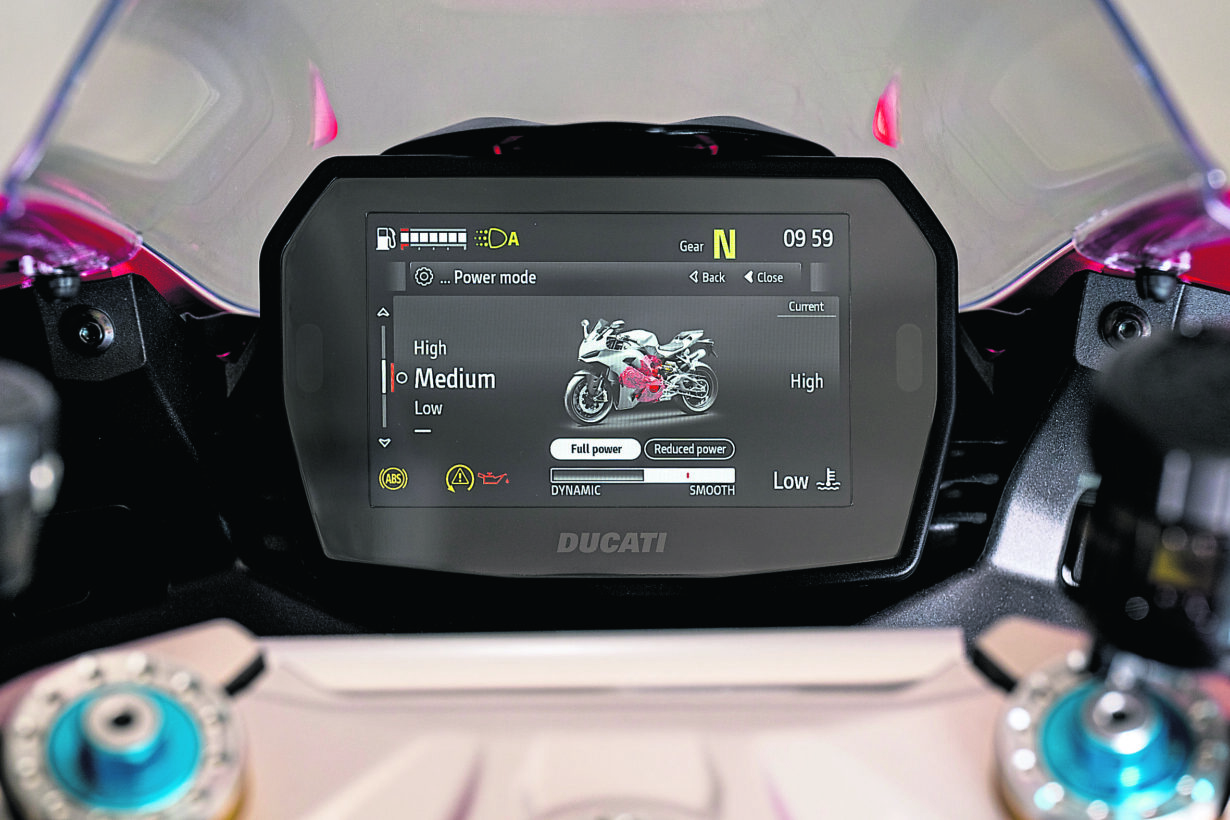
The new 5” dash is definitely a much better option than the one found on the old bike, but it’s not quite as large or fancy as the Panigale V4’s. I also found it super-intuitive to navigate, thanks to new switchgears, and the info on screen was always easy on the eye. There are three different display options (Road, Road Pro, Race) and mine was constantly in the latter, focusing purely on revs, gear selection, while the accessory track timing function not only showed me live sectors on the go, but also told me mercilessly that despite riding to my limits, I was still four seconds a lap slower than Ducati’s test rider. Still, what did that matter? I was having an absolute blast and beginning to appreciate that on very rare occasions, less truly can be more.
With the riding done, the sun setting and a cold beer calling my name, I couldn’t help but reflect on the simple brilliance of the V2. I honestly hadn’t expected it to be half as decent as it was, perhaps because I, too, had got caught up in the hype surrounding the model’s drop in output, and all that, but it is refreshing to think that Ducati had the balls to know what it wanted, stick to its guns, and turn out the kind of bike that can put Cheshire cat sized smiles on many a sports bike rider’s face. Even those with bad backs and achy knees, because while mulling over the experience, it hit me that my body wasn’t in tatters, as is often the case these days after a day on track. High bars, relaxed pegs and a screen that’s deceivingly protective all undoubtedly did their bit for my aging bones… and for that I’m thankful, as I dare say many riders that plan on smashing out big miles on the road (or track) will be, too.
The real question is, has Ducati gone too far in making this bike so usable, comfortable and a whole lot more practical? Well, by the time you read this we’ll have had the first round of WSBK. If the Panigale V2 isn’t on the supersport podium, there’s your answer.
Change of tune…
You’d be forgiven for thinking that for a bike that’d just won two world supersport titles – back-to-back – Ducati would be rewarding its class-dominating proposition with new shiny bits and more power – not knocking over 30bhp from its arsenal. So why have they done it? Well, the answer’s a broad one with a few different aspects to it.
Firstly, you have to take a look at the rivals the V2’s up against: the likes of Yamaha’s R9 and Triumph’s 765… plus the more traditional 600cc in-line-fours. Now, I skipped a lot of school but even I know that taking a nigh-on-litre bike to battle against conventional supersport machines is up there with fishing with dynamite… which is just a little frowned upon. The solution? To heavily chastise the V2 and level the playing field.
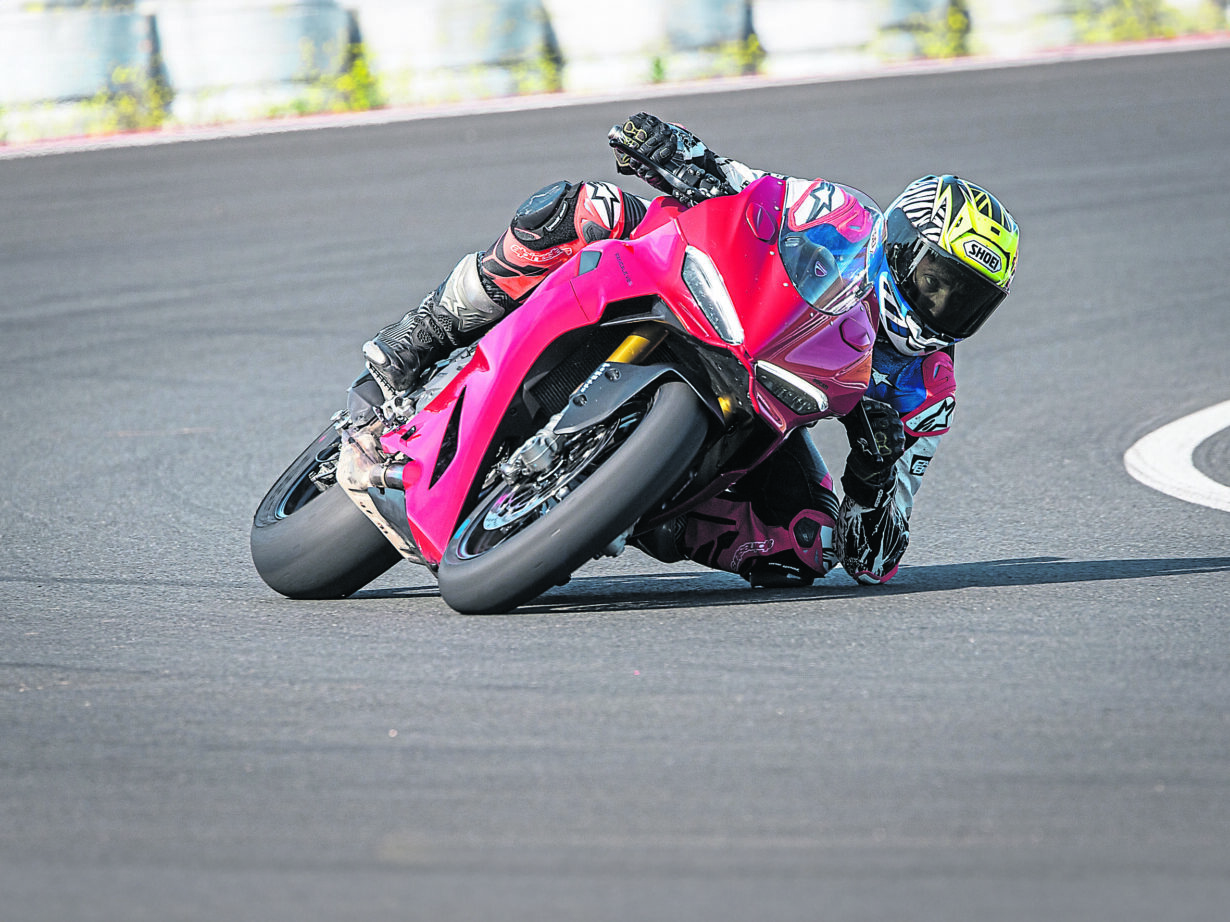
By culling power, adding weight and electronically governing the V2, it brought the package more in line with its rivals, but it would’ve also had Ducati questioning its need for a higher output, fancier desmodromic engine when a more traditional and cheaper valve train system would more than cut it to match its rivals’ rough output of around 120bhp. So, from a racing point of view, there’s a good reason for the new engine – the last one was overkill. The other reason, which ticks the commercial box, is the need for a common motor across different platforms.
Ducati’s a big player in the sub-litre, v-twin market and up until the intro of this new engine it sported the fancier Desmo-driven Superquadro engine (Panigale) at one end of the spectrum and the more traditional, road application inclined Testastretta Evoluzione lump used in the likes of the V2 Multistrada, Monster, DesertX and Hyermotard.
So, why build two engines when you could have one, not only meeting the criteria for all applications, but ticking the box for new tree-hugging legislation, etc., in one foul swoop? While it might not be justifiable to those that want a 150bhp v-twin of old, an alternative might have been no new v-twin motor at all – which could have meant the death knell for the Panigale V2. Surely, that’s a reality that no one would have wanted… least of all Ducati.
Specs: Ducati Panigale V2 S
Engine:
Type: 890cc, 90˚ V-twin, variable valves, liquid-cooled
Bore x Stroke: 96mm x 61.5mm
Compression: 13.1:1
Fuelling: EFI
Claimed Power: 119bhp @ 10,750rpm
Claimed Torque: 93.3Nm @ 8250rpm
Chassis:
Frame: Aluminium monocoque
F Suspension: Fully adjustable, 43mm Ohlins NIX30
R suspension: Ohlins monoshock with full adjustability
Front brakes: Brembo M50, four-piston monobloc calipers
Rear brake: Twin-piston caliper, 245mm disc
Electronics:
Riding Modes: Yes
Traction Control: Yes
ABS: Yes
Quickshifter/Autoblipper: Yes
Wheelie Control: Yes
Launch Control: Yes
Dimensions:
Wheelbase: 1465mm
Seat Height: 837mm
Wet Weight: 179kg (no fuel)
Fuel Capacity: 15 litres
Info:
Price: £16,995
From: www.ducati.com


